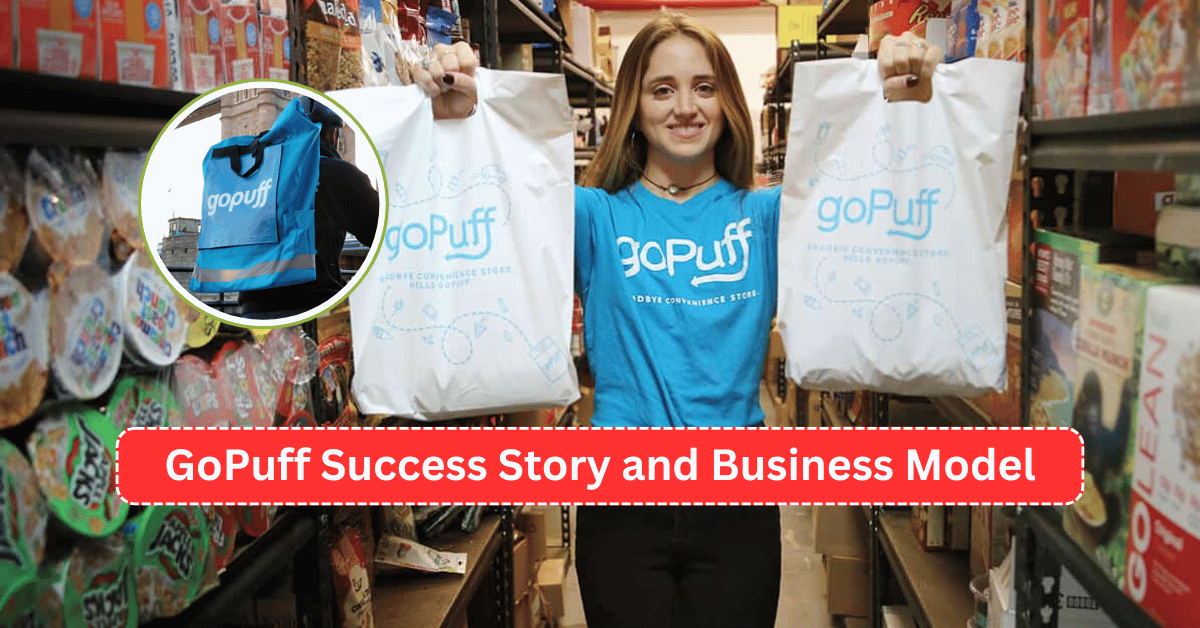GoPuff Success Story: GoPuff, a rapid delivery service that has redefined the convenience store concept, has become a household name in the U.S. Known for delivering everything from snacks to household essentials at any hour of the day.
GoPuff’s journey from a small startup to a billion-dollar company is nothing short of impressive.
In this article, we’ll explore the GoPuff success story, shedding light on how it grew to become a leader in the on-demand delivery space and how its unique business model contributes to its continuous growth.

Vision Behind GoPuff, GoPuff Success Story
GoPuff started in 2013 as a vision shared by two Drexel University students, Yakir Gola and Rafael Ilishayev. The duo noticed a gap in the market — people wanted quick and easy access to everyday essentials without leaving their homes, especially during odd hours.
What started as an idea to deliver hookah products in their college town quickly evolved into a much broader service.
Today, GoPuff offers everything from groceries and personal care items to over-the-counter medicine and alcohol, all within 15-30 minutes.
How GoPuff Started?
Yakir Gola and Rafael Ilishayev launched GoPuff while still in college. They initially used their own cars for deliveries, managing everything manually.
As demand grew, they expanded their inventory and began offering a broader range of products. What set them apart early on was their decision to warehouse their own products rather than acting as a middleman, allowing for faster and more efficient delivery times.
In 2015, just two years after launching, GoPuff secured its first major round of funding, which accelerated its expansion beyond Philadelphia. By focusing on cities with a high density of college students and young professionals, the founders found a natural customer base that appreciated the convenience of late-night deliveries.
The company’s laser focus on improving speed, convenience, and product variety resonated well with its target audience, paving the way for national expansion.
GoPuff Business Model
What makes GoPuff’s business model unique is its decision to function more like a digital convenience store than a traditional delivery service.
Most delivery platforms, like Uber Eats or Instacart, rely on partnerships with third-party retailers. GoPuff, on the other hand, owns and operates its own network of micro-fulfillment centers.
Here are the key components of the GoPuff business model:
1. Micro-Fulfillment Centers
GoPuff doesn’t rely on outside retailers. Instead, the company stocks its own products in strategically located warehouses, which are called micro-fulfillment centers.
These centers are smaller than traditional warehouses but large enough to store all the essentials people need on a daily basis.
This setup allows GoPuff to keep delivery times short — usually under 15 to 30 minutes — because their drivers only need to travel a short distance from the fulfillment center to the customer.
2. Flat Delivery Fee
GoPuff charges a flat delivery fee, typically around $2.95, no matter the order size. This is different from other delivery platforms that may charge varying fees based on distance, order size, or demand.
There’s also a membership option called GoPuff Fam, which offers unlimited free delivery for a small monthly fee.
3. Product Variety
One of the reasons behind the GoPuff success story is the company’s impressive variety of products. It offers over 4,000 items, including snacks, drinks, cleaning supplies, personal care items, baby products, and even alcohol in certain locations.

This variety makes GoPuff a one-stop shop for many customers, ensuring they can get what they need without switching between multiple delivery platforms.
4. Late-Night Availability
GoPuff operates 24/7 in many locations, making it the go-to service for people in need of essentials late at night.
This late-night availability has become one of its defining features, especially for students, night owls, and busy professionals who appreciate the convenience of getting items delivered at unconventional hours.
5. Direct-to-Consumer Model
Since GoPuff owns its products and controls the entire delivery process, the company doesn’t rely on third-party merchants. This direct-to-consumer model allows it to offer competitive prices while maintaining a high level of service quality.
Milestones in the GoPuff Journey
GoPuff’s growth trajectory has been nothing short of remarkable. In 2020, the company raised over $1 billion in venture capital funding, leading to a valuation of around $15 billion.
That same year, GoPuff expanded its services by acquiring BevMo!, a popular liquor store chain, which allowed them to offer alcohol delivery in new markets.
GoPuff’s continuous innovation and expansion efforts, including the acquisition of other delivery services like Fancy and Liquor Barn, have helped solidify its position as a market leader in the on-demand delivery space.
Conclusion
The GoPuff success story is a testament to how a simple idea, driven by innovation and customer focus, can evolve into a billion-dollar business.
By staying true to their original vision of delivering convenience to consumers, Yakir Gola and Rafael Ilishayev have built a business that not only disrupted the traditional convenience store model but also created a blueprint for success in the on-demand delivery industry.
Read These Also:
FAQs: GoPuff Success Story
What is GoPuff?
GoPuff is an on-demand delivery service that offers quick delivery of everyday essentials, including snacks, drinks, cleaning supplies, and even alcohol in certain locations. It operates through micro-fulfillment centers and delivers directly to consumers.
Is GoPuff available 24/7?
Yes, GoPuff operates 24/7 in many of its locations, making it convenient for customers to get items delivered at any time of day.






